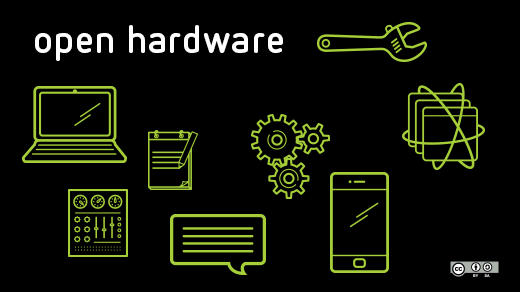Open hardware is the physical foundation of the open movement. It is through understanding, designing, manufacturing, commercializing, and adopting open hardware, that we built the basis for a healthy and self-reliant community of open. And the year of 2014 had plenty of activities in the open hardware front.
Opensource.com published a set of new resources on open hardware, including an accessible definition. In March, we celebrated open hardware with a full week of articles on various topics. The editorial staff had fun at their open hardware day with 3D printers, Arduinos, and quadcopters. And open hardware continued in the news throughout year in many different areas.
Here are some of the highlights.
Education
Limor Fried opened the year by sharing the continued and persistent activity of Adafruit to educate a new generation of makers and hackers. She brought attention to larger events such as the Maker Faire, the Open Source Hardware Summit, and these regular sessions at Adafruit: Ask an Engineer and Show and Tell.
Russell Dickenson interviewed Jezra Johnson Lickter on the lost art of tinkering and how it can be revived today thanks to the wide availability of inexpensive electronics and wide availability of information. Jezra celebrates the ephemeral nature of tinkering, focusing on curiosity, unleashing creativity, and making things more than they previously were.
Jen Wike Huger interviewed Jennifer Davidson from ChickTech on their initiatives to bring more girls into technology and engineering. In particular, she highlighted early college experience for high school girls, working on open source, and open hardware educational projects, like the Open HeARTware workshop held at OSCON.
Makers
Ruth Suehle opened the year with a review of the Maker Movement Manifesto by Mark Hatch, where he writes about the experiences of makers around the world who are changing the way new products are conceived, designed, and prototyped. Above all, the manifesto is a call for us to participate in the democratic experience of making.
This article in turn inspired the review of the book Makers: The New Industrial Revolution, where Chris Anderson recounts the emergence of the maker movement as the image of the second industrial revolution. Chris also shares his experience with founding a prosperous business consistent with the values of the DIY community.
The democratization of the maker movement was illustrated also in an article on the creation of maker spaces in public libraries, where 3D printers and scanners are made available to the public and local volunteers provide training to their fellow neighbors.
The most significant event of the year in the Maker space, is without a doubt, the birth of the e-NABLE community, as recounted in this interview by Jen Wike Huger of Jen Owen, of the e-Nable community. The worldwide e-NABLE community of volunteers interact online to design, manufacture, and distribute 3D printed prosthetic hands for children. Another member of the community, and user of the tech, Peregrine Hawthorn shares in this article how he brought an audience of 4,600 engineers at an Intel conference to their feet. This a great illustration of how a technologically-empowered community of committed volunteers can drive social change at an unprecedented rate.
3D printing
Rapid innovation continued in the 3D printing space. We started the year with a review of the Printrbot Simple 3D printer, a low cost kit, that after a few hours of assembly, puts quality 3D printing at the reach of every aspiring maker willing to tinker with it. We learned also about the entrance of Arduino into the 3D printing market, an exciting development to be followed closely in 2015.
Staying true to the principles of free and open source takes great dedication and effort. This is what the good people at Aleph Objects have achieved in their development of the LulzBot printers. Their journey was recounted by Ginny Skalski in this interview with Jeff Moe. They decline the use of patents and instead embrace rapid innovation to establish prior art. They also continuously publish their designs, sharing them as they are being developed, and in this way are able to welcome community contributions as well. For the second year in a a row, the company also offered the winner of the Opensource.com Holiday Giveaway a Lulzbot Taz 4 3D printer!
Electronics
In the general electronics front, we saw the development of an open source DIY Oscilloscope by Bryn Reeves. He combined an OLPC laptop with an oscilloscope box whose software was licensed under GPL. This allowed Bryn to get things up an running after a few sessions with his trusty Vim editor.
Lauren Egts interviewed Ken Burns, founder of TinyCircuits. A company initially funded through Kickstarter, TinyCircuits produces small modular components compatible with the Arduino platform, such as the TinyDuino. Lauren was later interviewed by Dave Egts (her father) and Gunnar Hellekson in their technology podcast show.
We also learned about LittleBits, a collection of modular components that we can easily snap together in order to build electronics projects. LittleBits makes its designs publicly available and fosters a community of contributors who enthusiastically share their projects.
JR shared his design of pedalSHIELD, a programmable open source and open hardware guitar pedal, made for guitarists, hackers, and programmers. It was designed using the open source tool KiCad and the open hardware Arduino platform.
Arduino
Michael Harrison reviewed the Arduino for Beginners book, designed to teach beginners how to build fascinating gadgets with the Arduino microcontroller.
We reviewed the Arduino Starter Pack from Adafruit and shared our experience playing with basic projects from the very complete set of Arduino examples. It was highly recommended as an easy way to start in the Arduino world.
Jonathan Muckell shared his experience preparing and teaching a university class on physical computing using open hardware and open source software. This course, combining Arduinos, Raspberry Pis, and 3D printing, rekindles students' fascination when they apply programming and computation to situations where they affect the physical world.
Jon Davis told us about his high school class, in which students get to build scientific instruments using Arduino boards. Students benefited from the wealth of support resources that the Arduino community has developed and made publicly available. Jon wisely pointed out that: "Teaching is open source."
Hugo Silva taught us about the use of the BITalino sensor in several cool projects. BITalino is a low-cost hardware and software kit, designed for reading body signals. With it, a project can read muscle, heart, and nerve signals and process them to control devices that react to human interaction, or to simply monitor body functions. Hugo shares interesting applications ranging from drone controllers to assisting devices for Lou Gehrig's Disease (ALS) patients.
Raspberry Pi
It was a great year for the Raspberry Pi team. We celebrated the release of the Raspberry Pi B+ board, and reviewed it, and later reviewed the Raspberry Pi A+ model too. the board both bring great improvements in power consumption and connectivity, while keeping the price level in the B+ and reducing it by $5 in the A+ model. These new models expanded the number of choices for tinkerers to find the right board to fit any project.
Ruth Suehle shared her favorite Raspberry Pi projects, including things as diverse as R2D2 hacks, home automation, sky photography, FM radio, and home brewing.
Lauren Egts ventured fearlessly into open hardware, incorporating a Raspberry Pi as a light controller for a Juggler’s performance. She unleashed her software and hardware hacking skills to combine a Raspberry Pi, ArchLinux, and Pibrella, to control a set of LED inside the juggling clubs. It's really worth seeing them in action, in this video at the 3:40 mark.
Conclusion
The year of 2014 was vibrant with open hardware activity and brought the open source community closer together with everyone working on very interesting projects and initiatives ranging from education to medicine. The future is bright for our combined communities.







2 Comments